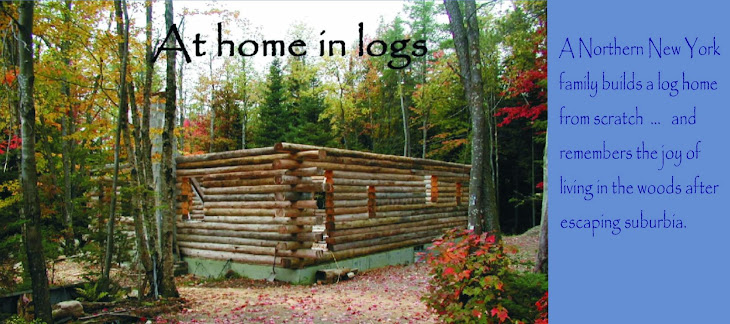My father begins every set of instructions with "First, catch and clean one large.... " (for example, instructions involving Scotch whisky would begin with, "first, catch and clean one large Scotsman"). This reference to my father's idiosyncrasy will probably be the closest he ever comes to the world of blogging. But it may give you insight into yours truly. So, after we 'caught and cleaned' our logs, we [by which I mean Bob, our friends Rob and Craig, the ongoing aid of Bob's father, Paul of course, coworkers Johnny and Chris, and me for three days last November] toiled over them to make them into a house. This process began in fall 2007 after the basement was in place. Boring, notching, and securing the sill logs (those directly on the sill plate on the walls of the basement) and floor joists requires a few more steps, which I won't go into. [Although, having said that, I'm sure The Husband would LOVE to explain it in detail to you. Just ask.] The process outlined below (and in subsequent posts) describes the arduous arduousness involved in creating the average wall log.
First, select a log from the rapidly dwindling stack.

Should have taken a picture when the stack was 10 feet tall. C'est la vie.
Next, pick up log with ca. 1972 Allis-Chalmers tractor (affectionately named "Alice") and transport to Hud-Son portable sawmill. Mill two sides of the log to create an 8-inch thick log (resulting in 8" courses).
 The Husband and friend Rob mill log, with Alice standing by.
The Husband and friend Rob mill log, with Alice standing by.
9-14-2007
Move log to work area, place atop sawhorses, and measure length against need. If considerably longer than the place in the wall calls for, trim with chainsaw.

11-10-2008
Using the coolest invention ever, snap chalk line to mark center of log. If you've never used one of these, pop down to your local hardware store and ask for a demonstration. It's a long string, wound around a central spool inside a casing that contains blue chalk dust (not unlike that used on a pool cue). You draw out the string along the length of the log, carefully laying it in line with the center mark on each end. Then, you pick up the line and snap it back against the log, to create a blue line down the center. Wicked cool.

What the photo doesn't show is the difficulty in grabbing a thin string with completely numb fingers. The temp when this Nov. picture was taken was about 35 degrees F.
-------------------
Tune in next time for the continuing story .... 'Logs of Our Lives'

No comments:
Post a Comment